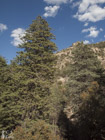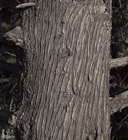Conservation Status

Hesperocyparis arizonica
(Greene) Bartel (2009)
Common names
Arizona or roughbark Arizona cypress (Peattie 1950), ciprés (Elmore & Janish 1976).
Taxonomic notes
Synonymy: see POWO (accessed 2023.12.16). Type locality: "the mountains back of Clifton, in the extreme eastern part of Arizona, on the first day of September, 1880" (Greene 1882).
In the past, there has been considerable debate about the actual extent of this species (see Hesperocyparis for a discussion of the relationship between this and other, closely related Hesperocyparis taxa in northwest Mexico and the adjacent Southwest U.S.). Little (1966, 1970) assigned Hesperocyparis arizonica, H. glabra, H. montana, H. nevadensis and H. stephensonii status as varieties of H. arizonica, and Eckenwalder (1993) did not even recognize the varieties, although all were again recognized in the comprehensive morphological analysis of Farjon (2005). However, each of these taxa has been described as a distinct species, having different distributions and consistent differences in morphology, chemistry, and molecular genetic characters (Wolf 1948, Little 1966, 1970, Silba 1981, Bartel et al. 2003, Little et al. 2004, Farjon 2005, Little 2006, Adams et al. 2010). Certain authors have noted that the morphological differences between the species are for the most part related to their differing ecological settings (e.g., more waxy cuticles in the more desert-adapted groups, serotinous cones in populations experiencing frequent fire). However, the differences include certain cone characters, which are conventionally interpreted as taxonomically significant in the Cupressaceae; and the molecular genetic differences (Little et al. 2004, Little 2006) have no apparent relationship to ecological variability. It is thus appropriate to treat them as distinct taxa. They are here treated as species.
Description
"[T]ree up to 25 m high; bark gray to black-brown, furrowed; branches horizontally spreading; crown broadly conical; shoots short, thick, four-sided, spreading in all directions; foliage scale-like, mostly 2 mm long, acuminate, usually glaucous-green; resin gland on the dorsal side of the leaf not conspicuous or only slightly so; cones shortly petiolated, globose, 2-3 cm large, dark red-brown, bluish pruinose, composed of 6 to 8 scales with prominent dorsal processes; seeds 4-5 mm long, dark brown, occasionally bluish pruinose, cca 90-120 to a cone; cotyledons 4-5" (Vidakovic 1991). See García Esteban et al. (2004) for a detailed characterization of the wood anatomy.
Distribution and Ecology
USA: Texas, New Mexico, SE Arizona; Mexico: Chihuahua, Coahuila, Durango, Tamaulipas, Zacatecas; at 1000 to 1500 m in the US, and up to 2200 m in Mexico (Vidakovic 1991, Farjon 1998). Bartel (1993) identifies it as occurring from Big Bend in Texas, northwest to Greenlee County and the Santa Catalina Mountains in Arizona, with Hesperocyparis glabra occurring in still more northwestern portions of Arizona. Adams (2008) places it in the 4-corners area of Coahuila-Chihuahua-New Mexico-Arizona and northwest from there through central Arizona to the Prescott area. Hardy to Zone 7 (cold hardiness limit between -17.7°C and -12.2°C) (Bannister and Neuner 2001).
Data from USGS (1999). Points plotted as tree icons represent isolated or approximate locations.
Remarkable Specimens
The largest recorded specimen is 28 m tall, dbh 194 cm, crown spread 15 m, in the Santa Catalina Mountains of Arizona (American Forests 2000). The largest known outside of the species' native range is a specimen 28 m tall and 273 cm girth (87 cm dbh) in Tarbes, Hautes-Pyrénées, France, as measured 2020.05.15 by Dominique Béziat (Monumental Trees 2020).
Ethnobotany
The species has been used in one dendroecological study (Parker 1980), but no other applications are recorded.
Observations
Can be seen at several points along the Mt. Lemmon Highway, Santa Catalina Mountains, Arizona; most notably, in Seven Cataracts Canyon.
In Big Bend National Park, Texas, there is an extensive occurrence in Boot Canyon at elevations of 6,500 to 7000 feet (1980 to 2130 m). (Tom Hamilton email 2020.01.18).
Remarks
The epithet refers to the type locality for this species, in Arizona (Greene 1882).
Citations
Adams, Robert P. 2008. Junipers of the World: The Genus Juniperus. Second edition. Trafford Publishing. Brief versions of the descriptions are available online at Adam's website, www.juniperus.org.
Adams, R. P., J. A. Bartel, D. Thornburg, and A. Allgood. 2010. Geographic variation in the leaf essential oils of Hesperocyparis arizonica and H. glabra. Phytologia 92(3):366-387. Available at www.phytologia.org.
American Forests 2000. The National Register of Big Trees 2000. Washington, DC: American Forests.
Bartel, J. A. 1993. Cupressaceae: Cypress family. Journal of the Arizona-Nevada Academy of Science 27:195-200.
Bartel 2009: described in Adams, R. P., J. A. Bartel and R. A. Price. 2009. A new genus, Hesperocyparis, for the cypresses of the western hemisphere. Phytologia 91(1):160-185.
Bartel, J. A., R. P. Adams, S. A. James, L. E. Mumba and R. N. Pandey. 2003. Variation among Cupressus species from the western hemisphere based on Random Amplified Polymorphic DNAs (RAPDs). Biochem. Syst. Ecol. 31:693-702.
Greene, E. L. 1882. New western plants. Bulletin of the Torrey Botanical Club 9(5): 64-65. http://www.cupressus.net/CUarizonicaGreene.html, courtesy of the Cupressus Conservation Project website.
Parker, A. J. 1980. The successional status of Cupressus arizonica. Great Basin Naturalist 40(3): 254-264.
See also
Adams, R. P. and J. A. Bartel. 2009. Geographic variation in Hesperocyparis (Cupressus) arizonica and H. glabra: RAPDs analysis. Phytologia 91(1):244-250.
Bisbee, Jeff. 2006. Photos at the Cupressus Conservation Project website.
Elwes and Henry 1906-1913 at the Biodiversity Heritage Library (applies to both C. arizonica and C. glabra). This series of volumes, privately printed, provides some of the most engaging descriptions of conifers ever published. Although they only treat species cultivated in the U.K. and Ireland, and the taxonomy is a bit dated, still these accounts are thorough, treating such topics as species description, range, varieties, exceptionally old or tall specimens, remarkable trees, and cultivation. Despite being over a century old, they are generally accurate, and are illustrated with some remarkable photographs and lithographs.
Farjon (2005) provides a detailed account, with illustrations.






